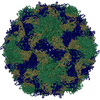+ Open data
Open data
- Basic information
Basic information
| Entry | Database: PDB / ID: 1xyr | ||||||
|---|---|---|---|---|---|---|---|
| Title | Poliovirus 135S cell entry intermediate | ||||||
 Components Components | (Genome polyprotein, Coat protein ...) x 7 | ||||||
 Keywords Keywords |  VIRUS / VIRUS /  BETA BARREL / BETA BARREL /  VIRAL CAPSID / CELL ENTRY INTERMEDIATE / Icosahedral virus VIRAL CAPSID / CELL ENTRY INTERMEDIATE / Icosahedral virus | ||||||
| Function / homology |  Function and homology information Function and homology informationsymbiont-mediated suppression of host translation initiation / symbiont-mediated suppression of host cytoplasmic pattern recognition receptor signaling pathway via inhibition of MDA-5 activity / symbiont-mediated suppression of host cytoplasmic pattern recognition receptor signaling pathway via inhibition of RIG-I activity /  picornain 2A / symbiont-mediated suppression of host mRNA export from nucleus / symbiont-mediated suppression of host cytoplasmic pattern recognition receptor signaling pathway via inhibition of MAVS activity / symbiont genome entry into host cell via pore formation in plasma membrane / picornain 2A / symbiont-mediated suppression of host mRNA export from nucleus / symbiont-mediated suppression of host cytoplasmic pattern recognition receptor signaling pathway via inhibition of MAVS activity / symbiont genome entry into host cell via pore formation in plasma membrane /  picornain 3C / ribonucleoside triphosphate phosphatase activity / T=pseudo3 icosahedral viral capsid ...symbiont-mediated suppression of host translation initiation / symbiont-mediated suppression of host cytoplasmic pattern recognition receptor signaling pathway via inhibition of MDA-5 activity / symbiont-mediated suppression of host cytoplasmic pattern recognition receptor signaling pathway via inhibition of RIG-I activity / picornain 3C / ribonucleoside triphosphate phosphatase activity / T=pseudo3 icosahedral viral capsid ...symbiont-mediated suppression of host translation initiation / symbiont-mediated suppression of host cytoplasmic pattern recognition receptor signaling pathway via inhibition of MDA-5 activity / symbiont-mediated suppression of host cytoplasmic pattern recognition receptor signaling pathway via inhibition of RIG-I activity /  picornain 2A / symbiont-mediated suppression of host mRNA export from nucleus / symbiont-mediated suppression of host cytoplasmic pattern recognition receptor signaling pathway via inhibition of MAVS activity / symbiont genome entry into host cell via pore formation in plasma membrane / picornain 2A / symbiont-mediated suppression of host mRNA export from nucleus / symbiont-mediated suppression of host cytoplasmic pattern recognition receptor signaling pathway via inhibition of MAVS activity / symbiont genome entry into host cell via pore formation in plasma membrane /  picornain 3C / ribonucleoside triphosphate phosphatase activity / T=pseudo3 icosahedral viral capsid / host cell cytoplasmic vesicle membrane / endocytosis involved in viral entry into host cell / picornain 3C / ribonucleoside triphosphate phosphatase activity / T=pseudo3 icosahedral viral capsid / host cell cytoplasmic vesicle membrane / endocytosis involved in viral entry into host cell /  : / nucleoside-triphosphate phosphatase / protein complex oligomerization / monoatomic ion channel activity / : / nucleoside-triphosphate phosphatase / protein complex oligomerization / monoatomic ion channel activity /  RNA helicase activity / induction by virus of host autophagy / RNA helicase activity / induction by virus of host autophagy /  RNA-directed RNA polymerase / symbiont-mediated suppression of host gene expression / viral RNA genome replication / cysteine-type endopeptidase activity / RNA-directed RNA polymerase / symbiont-mediated suppression of host gene expression / viral RNA genome replication / cysteine-type endopeptidase activity /  RNA-dependent RNA polymerase activity / DNA-templated transcription / host cell nucleus / structural molecule activity / virion attachment to host cell / RNA-dependent RNA polymerase activity / DNA-templated transcription / host cell nucleus / structural molecule activity / virion attachment to host cell /  proteolysis / proteolysis /  RNA binding / RNA binding /  ATP binding / ATP binding /  membrane / membrane /  metal ion binding metal ion bindingSimilarity search - Function | ||||||
| Biological species |   Human poliovirus 1 Human poliovirus 1 | ||||||
| Method |  ELECTRON MICROSCOPY / ELECTRON MICROSCOPY /  single particle reconstruction / single particle reconstruction /  cryo EM / Resolution: 11 Å cryo EM / Resolution: 11 Å | ||||||
 Authors Authors | Bubeck, D. / Filman, D.J. / Cheng, N. / Steven, A.C. / Hogle, J.M. / Belnap, D.M. | ||||||
 Citation Citation |  Journal: J Virol / Year: 2005 Journal: J Virol / Year: 2005Title: The structure of the poliovirus 135S cell entry intermediate at 10-angstrom resolution reveals the location of an externalized polypeptide that binds to membranes. Authors: Doryen Bubeck / David J Filman / Naiqian Cheng / Alasdair C Steven / James M Hogle / David M Belnap /  Abstract: Poliovirus provides a well-characterized system for understanding how nonenveloped viruses enter and infect cells. Upon binding its receptor, poliovirus undergoes an irreversible conformational ...Poliovirus provides a well-characterized system for understanding how nonenveloped viruses enter and infect cells. Upon binding its receptor, poliovirus undergoes an irreversible conformational change to the 135S cell entry intermediate. This transition involves shifts of the capsid protein beta barrels, accompanied by the externalization of VP4 and the N terminus of VP1. Both polypeptides associate with membranes and are postulated to facilitate entry by forming a translocation pore for the viral RNA. We have calculated cryo-electron microscopic reconstructions of 135S particles that permit accurate placement of the beta barrels, loops, and terminal extensions of the capsid proteins. The reconstructions and resulting models indicate that each N terminus of VP1 exits the capsid though an opening in the interface between VP1 and VP3 at the base of the canyon that surrounds the fivefold axis. Comparison with reconstructions of 135S particles in which the first 31 residues of VP1 were proteolytically removed revealed that the externalized N terminus is located near the tips of propeller-like features surrounding the threefold axes rather than at the fivefold axes, as had been proposed in previous models. These observations have forced a reexamination of current models for the role of the 135S particle in transmembrane pore formation and suggest testable alternatives. | ||||||
| History |
| ||||||
| Remark 999 | SEQUENCE VP1: Chain 1 consists of residues 71-302 of VP1. The residues that make up Chain 8 have ...SEQUENCE VP1: Chain 1 consists of residues 71-302 of VP1. The residues that make up Chain 8 have been identified as residues 42-52 but the identification is very tentative at this point. Residues 1-41 and 53-70 of VP1 are not present in the model. The authors suspect that residues 1-41 are mostly disordered, and that residues 53-70 may be differently ordered than in the native, but are not buildable at this resolution. VP2: Chain 2 consists of residues 28-264 of VP2. Chain 7 includes residues 13-26 from a (icosahedral-symmetry-related) copy of VP2. An alpha carbon from residue 27 is deliberately missing from the rigid-body model to create a hinge point for the modeling. Residues 26 (of chain 7) and 28 (of chain 2) are very far from one another in space because they come from different icosahedral-symmetry-related copies of VP2. Residues 1-12 of VP2 are probably disordered. Residues 265-272 of VP2 could not be modeled. VP3: Alpha carbons for 13 and 49 were deliberately omitted from the rigid-body model, to create hinge points for the modeling. C-terminal residues 232-235 or 233-235 (chain 3) are missing from all of the high-resolution (type 1 mahoney) native poliovirus structures, either due to disorder or proteolysis. AUTHOR HAS MODELLED RESIDUES 123 OF CHAIN 3 AS SER, WHEREAS THE CORRESPONDING RESIDUE 463 IN SWISSPROT IS PHE. THE AUTHOR CLAIMS THERE IS AN ERROR IN SWISSPROT AND THAT RESIDUE 123 SHOULD BE SER. |
- Structure visualization
Structure visualization
| Movie |
 Movie viewer Movie viewer |
|---|---|
| Structure viewer | Molecule:  Molmil Molmil Jmol/JSmol Jmol/JSmol |
- Downloads & links
Downloads & links
- Download
Download
| PDBx/mmCIF format |  1xyr.cif.gz 1xyr.cif.gz | 38.6 KB | Display |  PDBx/mmCIF format PDBx/mmCIF format |
|---|---|---|---|---|
| PDB format |  pdb1xyr.ent.gz pdb1xyr.ent.gz | 19.2 KB | Display |  PDB format PDB format |
| PDBx/mmJSON format |  1xyr.json.gz 1xyr.json.gz | Tree view |  PDBx/mmJSON format PDBx/mmJSON format | |
| Others |  Other downloads Other downloads |
-Validation report
| Arichive directory |  https://data.pdbj.org/pub/pdb/validation_reports/xy/1xyr https://data.pdbj.org/pub/pdb/validation_reports/xy/1xyr ftp://data.pdbj.org/pub/pdb/validation_reports/xy/1xyr ftp://data.pdbj.org/pub/pdb/validation_reports/xy/1xyr | HTTPS FTP |
|---|
-Related structure data
| Related structure data |  1133MC  1136MC  1137MC  1144MC  1145MC M: map data used to model this data C: citing same article ( |
|---|---|
| Similar structure data |
- Links
Links
- Assembly
Assembly
| Deposited unit | 
|
|---|---|
| 1 | x 60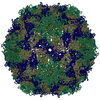
|
| 2 |
|
| 3 | x 5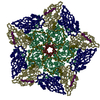
|
| 4 | x 6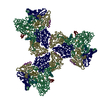
|
| 5 | 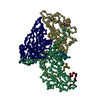
|
| Symmetry | Point symmetry: (Hermann–Mauguin notation : 532 / Schoenflies symbol : 532 / Schoenflies symbol : I (icosahedral : I (icosahedral )) )) |
- Components
Components
-Genome polyprotein, Coat protein ... , 7 types, 7 molecules 1235678
| #1: Protein | Mass: 26135.506 Da / Num. of mol.: 1 / Fragment: residues 649-880 / Source method: isolated from a natural source / Details: Virus was propogated in HELA cell suspension / Source: (natural)   Human poliovirus 1 / Genus: Enterovirus Human poliovirus 1 / Genus: Enterovirus / Species: Poliovirus / Species: Poliovirus / Strain: Type 1 Mahoney / References: UniProt: P03300 / Strain: Type 1 Mahoney / References: UniProt: P03300 |
|---|---|
| #2: Protein | Mass: 26244.518 Da / Num. of mol.: 1 / Fragment: residues 96-332 / Source method: isolated from a natural source / Details: Virus was propogated in HELA cell suspension / Source: (natural)   Human poliovirus 1 / Genus: Enterovirus Human poliovirus 1 / Genus: Enterovirus / Species: Poliovirus / Species: Poliovirus / Strain: Type 1 Mahoney / References: UniProt: P03300 / Strain: Type 1 Mahoney / References: UniProt: P03300 |
| #3: Protein | Mass: 20488.623 Da / Num. of mol.: 1 / Fragment: residues 390-571 / Source method: isolated from a natural source / Details: Virus was propogated in HELA cell suspension / Source: (natural)   Human poliovirus 1 / Genus: Enterovirus Human poliovirus 1 / Genus: Enterovirus / Species: Poliovirus / Species: Poliovirus / Strain: Type 1 Mahoney / References: UniProt: P03300 / Strain: Type 1 Mahoney / References: UniProt: P03300 |
| #4: Protein/peptide | Mass: 1214.349 Da / Num. of mol.: 1 / Fragment: residues 341-352 / Source method: isolated from a natural source / Details: Virus was propogated in HELA cell suspension / Source: (natural)   Human poliovirus 1 / Genus: Enterovirus Human poliovirus 1 / Genus: Enterovirus / Species: Poliovirus / Species: Poliovirus / Strain: Type 1 Mahoney / References: UniProt: P03300 / Strain: Type 1 Mahoney / References: UniProt: P03300 |
| #5: Protein/peptide | Mass: 3947.482 Da / Num. of mol.: 1 / Fragment: residues 354-389 / Source method: isolated from a natural source / Details: Virus was propogated in HELA cell suspension / Source: (natural)   Human poliovirus 1 / Genus: Enterovirus Human poliovirus 1 / Genus: Enterovirus / Species: Poliovirus / Species: Poliovirus / Strain: Type 1 Mahoney / References: UniProt: P03300 / Strain: Type 1 Mahoney / References: UniProt: P03300 |
| #6: Protein/peptide | Mass: 1488.682 Da / Num. of mol.: 1 / Fragment: residues 81-94 / Source method: isolated from a natural source / Details: Virus was propogated in HELA cell suspension / Source: (natural)   Human poliovirus 1 / Genus: Enterovirus Human poliovirus 1 / Genus: Enterovirus / Species: Poliovirus / Species: Poliovirus / Strain: Type 1 Mahoney / References: UniProt: P03300 / Strain: Type 1 Mahoney / References: UniProt: P03300 |
| #7: Protein/peptide | Mass: 1030.129 Da / Num. of mol.: 1 / Fragment: residues 620-630 / Source method: isolated from a natural source / Details: Virus was propogated in HELA cell suspension / Source: (natural)   Human poliovirus 1 / Genus: Enterovirus Human poliovirus 1 / Genus: Enterovirus / Species: Poliovirus / Species: Poliovirus / Strain: Type 1 Mahoney / References: UniProt: P03300 / Strain: Type 1 Mahoney / References: UniProt: P03300 |
-Experimental details
-Experiment
| Experiment | Method:  ELECTRON MICROSCOPY ELECTRON MICROSCOPY |
|---|---|
| EM experiment | Aggregation state: PARTICLE / 3D reconstruction method:  single particle reconstruction single particle reconstruction |
- Sample preparation
Sample preparation
| Component | Name: POLIOVIRUS 135S CELL ENTRY INTERMEDIATE / Type: VIRUS Details: 135S was made by heating native virus in 20mM HEPES pH 7.4, 2mM CaCl2 at 50 degrees for 3 minutes |
|---|---|
| Details of virus | Host category: VERTEBRATES / Type: VIRION |
| Natural host | Organism: Homo sapiens / Strain: HELA |
| Buffer solution | Name: 20mM HEPES, 2mM CaCl2 / pH: 7.4 / Details: 20mM HEPES, 2mM CaCl2 |
| Specimen | Conc.: 0.7 mg/ml / Embedding applied: NO / Shadowing applied: NO / Staining applied : NO / Vitrification applied : NO / Vitrification applied : YES : YES |
| Specimen support | Details: Quantifoil Holey Carbon Grids (R2/2) |
Vitrification | Cryogen name: ETHANE / Details: Plunge freezing into liquid ethane |
- Electron microscopy imaging
Electron microscopy imaging
| Experimental equipment |  Model: Tecnai F20 / Image courtesy: FEI Company |
|---|---|
| Microscopy | Model: FEI TECNAI F20 / Date: Sep 17, 2002 / Details: Focal pairs were taken |
| Electron gun | Electron source : :  FIELD EMISSION GUN / Accelerating voltage: 200 kV / Illumination mode: FLOOD BEAM FIELD EMISSION GUN / Accelerating voltage: 200 kV / Illumination mode: FLOOD BEAM |
| Electron lens | Mode: BRIGHT FIELD Bright-field microscopy / Nominal magnification: 50000 X / Calibrated magnification: 50000 X / Nominal defocus max: 3000 nm / Nominal defocus min: 900 nm / Cs Bright-field microscopy / Nominal magnification: 50000 X / Calibrated magnification: 50000 X / Nominal defocus max: 3000 nm / Nominal defocus min: 900 nm / Cs : 2 mm : 2 mm |
| Specimen holder | Temperature: 77 K / Tilt angle max: 0 ° / Tilt angle min: 0 ° |
| Image recording | Electron dose: 1 e/Å2 / Film or detector model: KODAK SO-163 FILM |
- Processing
Processing
| EM software |
| ||||||||||||
|---|---|---|---|---|---|---|---|---|---|---|---|---|---|
CTF correction | Details: CTF correction of each particle. Phase flipped correction for particles included in the orientation search, and deconvoluted and gaussian decay corrected for the particles used in the reconstruction | ||||||||||||
| Symmetry | Point symmetry : I (icosahedral : I (icosahedral ) ) | ||||||||||||
3D reconstruction | Method: icosahedrally symmetric model-based orientation search (PFT and EM3DR) Resolution: 11 Å / Num. of particles: 3641 / Nominal pixel size: 2.69 Å / Actual pixel size: 2.69 Å Magnification calibration: radial scaling to previous low-resolution reconstruction which had been calibrated to crystal structure of native virus Symmetry type: POINT | ||||||||||||
| Atomic model building | Protocol: RIGID BODY FIT / Space: RECIPROCAL Target criteria: amplitude-weighted phase error, and the summation of the squared model-based amplitudes. Details: METHOD--gradient search REFINEMENT PROTOCOL--Rigid body (chains 1 and 6 as one rigid body, chains 3 and 7 as one rigid body, chains 2 and 8 as individual rigid bodies, chain 5 placed along 5fold axis visually) | ||||||||||||
| Atomic model building | PDB-ID: 1HXS Accession code: 1HXS / Source name: PDB / Type: experimental model | ||||||||||||
| Refinement step | Cycle: LAST
|
 Movie
Movie Controller
Controller



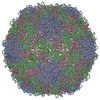
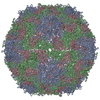
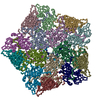
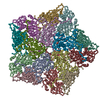
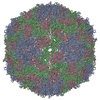
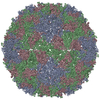
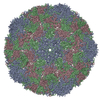
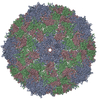
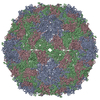
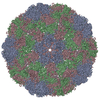
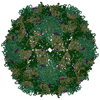
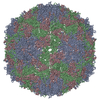
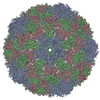
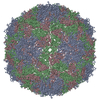

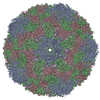
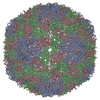

 PDBj
PDBj

